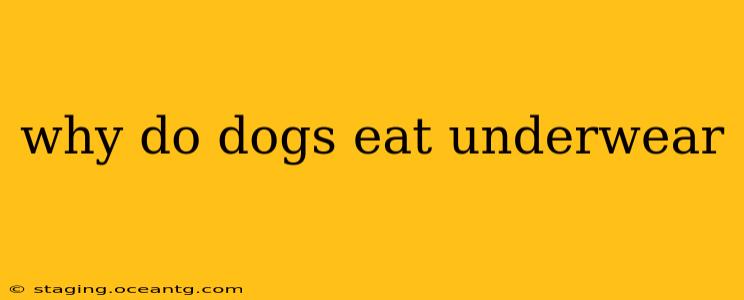Many dog owners have experienced the bewildering and sometimes disgusting phenomenon of their canine companion consuming their underwear. This seemingly bizarre behavior isn't as uncommon as you might think, and understanding the underlying reasons is crucial for addressing the issue and preventing future incidents. Let's delve into the various motivations behind this peculiar habit.
Why Do Dogs Eat Clothes in General? (Including Underwear!)
Dogs' motivations for eating fabric, including underwear, are multifaceted. It's rarely a sign of a malicious or defiant dog; rather, it's often a manifestation of underlying behavioral or medical issues. Let's explore some key reasons:
1. Pica:
This is a medical condition where animals (and humans!) compulsively eat non-nutritive substances. Pica in dogs can stem from various factors, including nutritional deficiencies, boredom, anxiety, or even underlying medical problems. If your dog exhibits a persistent and intense desire to eat non-food items, a veterinary checkup is essential to rule out any underlying health concerns.
2. Texture and Taste:
Underwear, particularly cotton or other soft materials, can be appealing to a dog's sense of taste and texture. The scent of their owner on the underwear might also play a role – dogs are naturally drawn to familiar scents. The act of chewing and swallowing can provide sensory stimulation.
3. Attention-Seeking Behavior:
Sometimes, dogs eat underwear to gain attention from their owners. If the act is followed by a reaction (even a negative one like scolding), the dog might repeat the behavior because it produced a response. This is a classic example of operant conditioning.
4. Stress and Anxiety:
Stress and anxiety are common culprits behind many canine behavioral issues, including eating non-food items. A dog experiencing anxiety might engage in destructive chewing behaviors like eating underwear as a coping mechanism.
5. Boredom and Lack of Stimulation:
A bored dog is a destructive dog. Without sufficient mental and physical stimulation, dogs might engage in undesirable behaviors like eating non-food items to alleviate boredom.
What If My Dog Ate Underwear?
If your dog has eaten underwear, the first step is to assess the situation.
- Assess the amount: Was it a small piece, or a significant amount of fabric?
- Observe your dog: Is your dog exhibiting any signs of distress, such as vomiting, diarrhea, or lethargy?
- Contact your veterinarian: While small amounts of cotton underwear are unlikely to cause severe harm, large quantities could lead to intestinal blockages. It's always best to consult your veterinarian, especially if you notice any unusual symptoms.
How Can I Prevent My Dog From Eating Underwear?
Prevention is key. Here are some strategies to help deter your dog from eating underwear:
- Keep underwear out of reach: Store your underwear in drawers, closets, or hampers that are inaccessible to your dog.
- Provide adequate enrichment: Ensure your dog receives plenty of physical exercise, mental stimulation, and social interaction to alleviate boredom and stress.
- Address underlying medical conditions: If your veterinarian identifies a medical condition such as pica, follow their treatment plan diligently.
- Positive reinforcement training: Reward your dog for good behavior and redirect them when they show interest in underwear. Never punish your dog; this can worsen anxiety and make the problem worse.
- Consider scent deterrents: Some dogs are sensitive to the scent of citrus fruits or other natural deterrents. You can try using these to discourage them from approaching laundry items.
What if My Dog Eats Other Non-Food Items?
The same principles apply if your dog exhibits pica and eats other non-food items. Always consult your veterinarian to rule out underlying medical conditions and develop a comprehensive plan to address the behavior. Consistent and patient training, coupled with providing a safe and stimulating environment, is crucial for success.
Remember, understanding the why behind your dog's behavior is the first step towards preventing this and other potentially harmful habits. By addressing the underlying causes and implementing preventative measures, you can help your dog develop healthier behaviors and maintain a happy and safe home environment.
